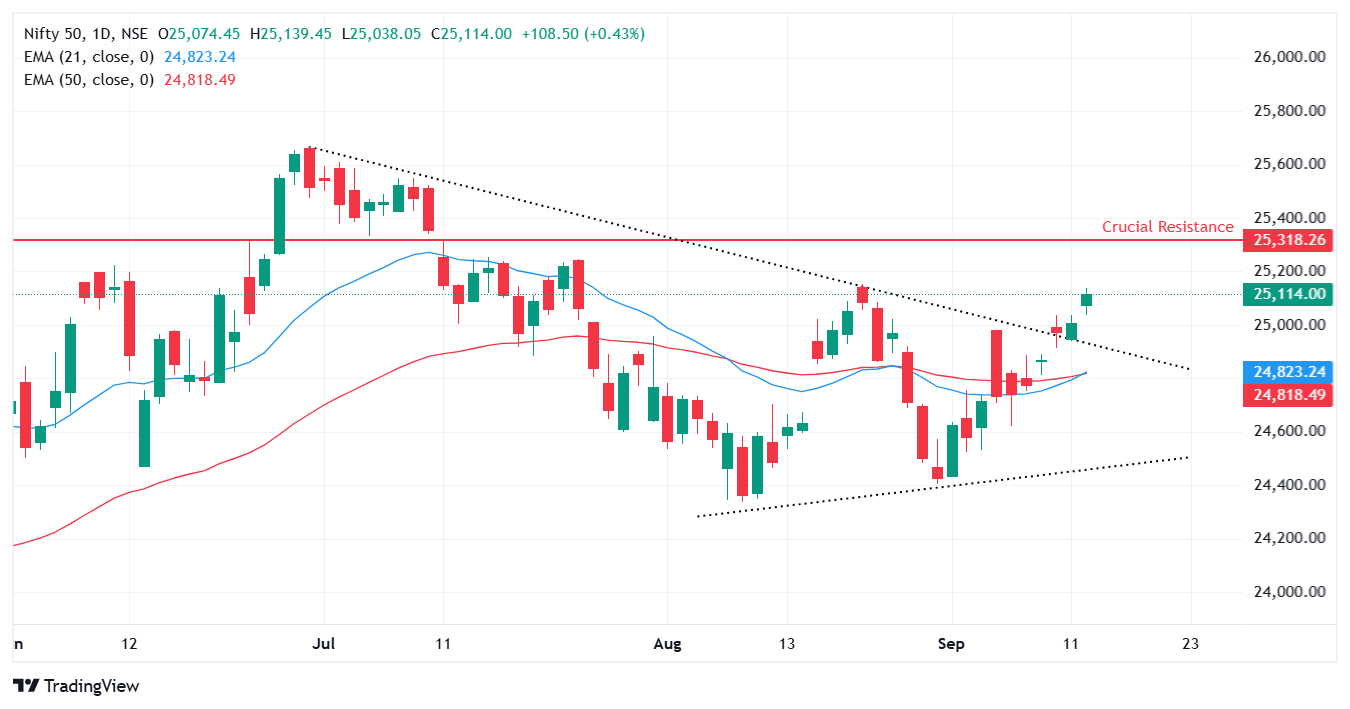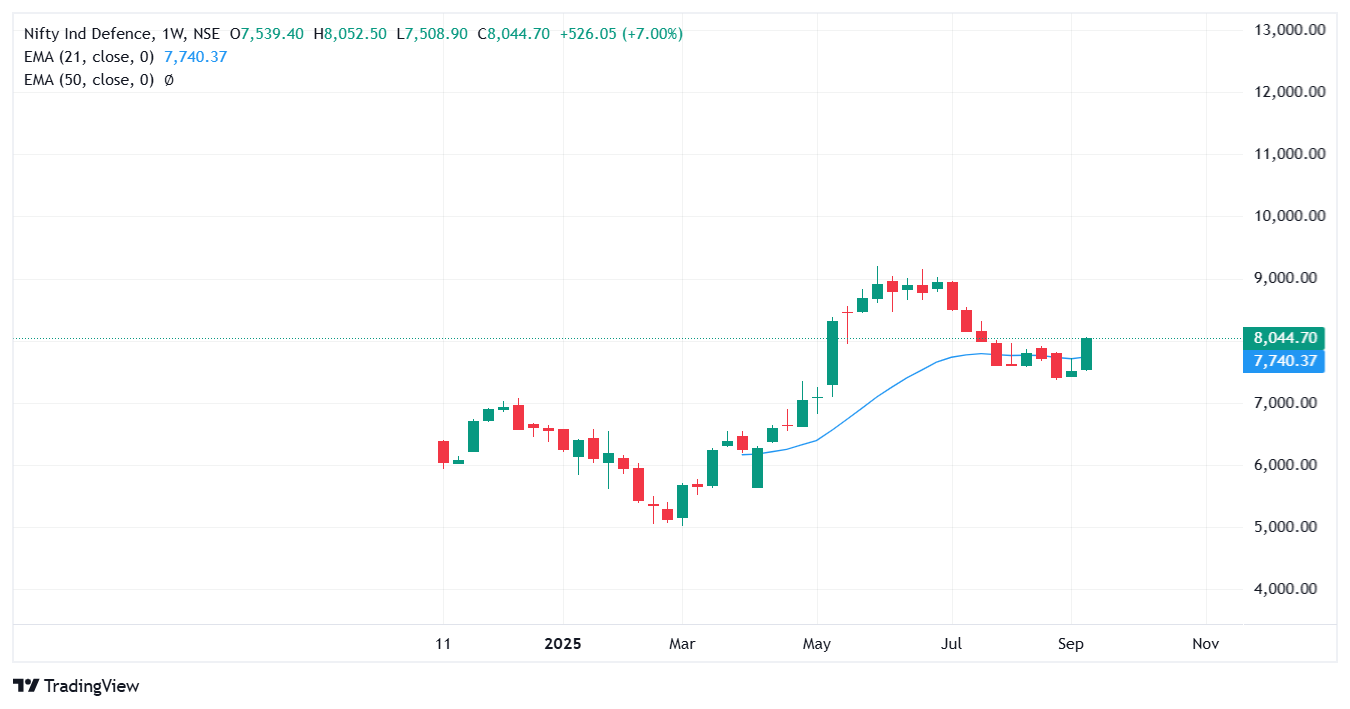Market News
Week ahead: Fed interest rate decision, wholesale inflation, India-US trade talks, defence stocks and FIIs flows
.png)
6 min read | Updated on September 14, 2025, 11:01 IST
SUMMARY
This week, markets will focus on the Federal Reserve’s interest rate decision on 17 September, with expectations firmly set on the Fed delivering its first rate cut of 2025. On the geopolitical front, President Trump has urged NATO allies to stop buying Russian oil and has proposed tariffs between 50% and 100% on China. Meanwhile, in India, the focus remains on continued FII selling and the outcome of ongoing India-U.S. trade talks

Fed rate cuts will be the most keenly watched trigger in next week.
Indian markets recorded their strongest weekly performance in almost three months, with the NIFTY50 index surging by 373 points to close at 25,114. The surge was driven by easing India–U.S. trade tensions, hopes of a U.S. Federal Reserve interest rate cut, and optimism surrounding the GST rationalisation. Nevertheless, the rupee hit new all-time lows, with foreign investors remaining net sellers.
Meanwhile, the broader market also continued to rebound, with the Mid-Cap 150 and Small-Cap 250 indices jumping by 1.8% and 1.6%, respectively. Sectorally, Consumer Durables (-1.0%) was the only notable laggard. The Defence index jumped by 7% in response to strong government policy signals. The IT index rose over 4%, as hopes of a Fed rate cut lifted Nasdaq peers. Meanwhile, the Nifty PSU Bank index added 3%.
Additionally, the India VIX index, often referred to as the market's "fear gauge", plummeted to a record low this week, closing at 10.12, the lowest it has been in years. This historic drop reflects a significant decrease in the expected short-term volatility of the NIFTY50. Typically, a VIX reading below 13 signals unusually calm market conditions, boosting market participants' confidence.
Market breadth
The breadth of the NIFTY50 index continued to improve, with the percentage of constituents trading above their 50-day moving average rising to around 66%. This uptrend extends the recovery from the deeply oversold levels of previous weeks.
.webp)
FIIs positioning in the index
As the September series progresses, Foreign Institutional Investors (FIIs) have continued to remain bearish in index futures. Short positions remain above 88%, while long positions are just 12%, indicating a slight reduction in their negative bias from last week. However, the long-to-short ratio still remains heavily skewed towards short contracts.
Their net open interest in index futures also decreased from -1.9 lakh contracts to -1.7 lakh contracts. This reduction in negative open interest suggests a slight easing of extreme selling pressure. It indicates that the FIIs are cautiously recalibrating their positioning amid mixed domestic and global cues.
.webp)
In the cash market, Foreign Institutional Investors (FIIs) have remained net sellers in the September series so far, offloading shares worth ₹9,245 crore. Conversely, the Domestic Institutional Investors (DIIs) have maintained a strong buying momentum, acquiring shares valued at ₹27,147 crore.
NIFTY 50 index
The NIFTY50 index confirmed the bullish piercing pattern on the weekly chart and reclaimed the psychologically crucial 25,000 on the closing basis. As highlighted on the daily chart below, the index has zoomed past the crucial trendline resistance connecting swing highs of August and June 2025.
Furthermore, the index is trading above the 21-day and 50-day exponential moving averages (EMAs), with a recent bullish crossover confirming strengthening short-term momentum. Unless the index slips below its 21-day EMA on a closing basis, the index may sustain bullish momentum.


In the United States, the Federal Reserve will conclude its two-day Federal Open Market Committee (FOMC) meeting on 17 September (Wednesday) with its rate decision. Amid cooling labour market concerns, markets are pricing in a 25 basis point rate cut with 96% probability, while 10% still expect a 50 basis point cut. The Fed’s current policy rate stands at 4.25%-4.50%, with the upcoming cut expected to be the first this year.
Meanwhile, in India, the wholesale inflation data for August is scheduled for release on Monday, 15 September. This will provide a crucial indication of input cost pressures ahead of the Reserve Bank of India’s (RBI) policy meeting later this month.
The Consumer Price Index (CPI), which measures retail inflation, was released on 12 September and showed an increase to 2.07% from 1.61% in July. This marked the first increase in ten months, although inflation remained close to the RBI’s lower target of 2%. The increase was primarily driven by higher prices of vegetables, meat and fish, oils and fats, personal care products, and eggs.
This week, the index broke decisively above 25,100, indicating continued support-based buying. It remained above last week's low and closed above the previous week's high, thus confirming the bullish piercing pattern.
For the upcoming sessions, traders should remain cautious. A close above the 25,150 zone would signal renewed bullish momentum. As long as NIFTY50 remains above its 21-day EMA on a closing basis, support-based buying is likely to persist.
Derivatives trading must be done only by traders who fully understand the risks associated with them and strictly apply risk mechanisms like stop-losses. The information is only for consumption by the client, and such material should not be redistributed. We do not recommend any particular stock, securities, or trading strategies. The securities quoted are exemplary and not recommendatory. The stock names mentioned in this article are purely to show how to do analysis. Make your own decision before investing.
About The Author
Next Story

